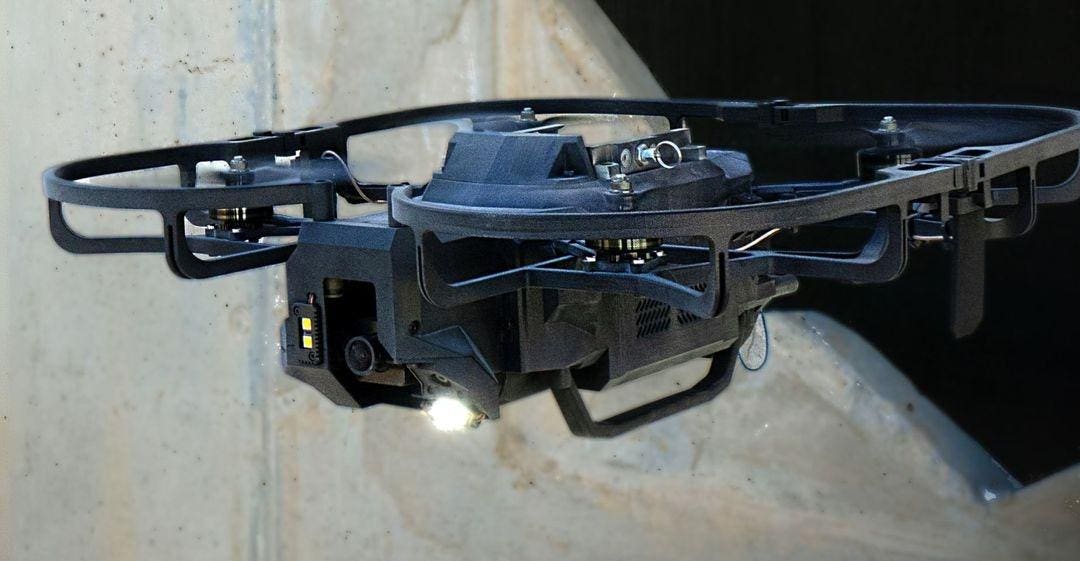The Scorpio 500 is a quadcopter attack drone able to seek and and strike targets inside buildings as … [+] wella s outdoors
XTEND
The Pentagon has announced a new contract to acquire Precision Strike Indoor & Outdoor (PSIO) small Unmanned Aerial Systems: kamikaze drone able to seek out and attack targets inside buildings. The contract with drone makers XTEND, previously noted for their advanced work on drones working in teams inside buildings in Gaza, brings a leap ahead in precision strike capabilities.
The contract is with the Pentagon’s Irregular Warfare Technical Support Directorate, an obscure outfit which develops capabilities for the military (“and Interagency customers”) to carry out operations typically involving clandestine, asymmetric strikes against the highest value targets. In the past this might have meant a Reaper drone taking out an insurgent leader on a balcony with a six-bladed Hellfire R9X ‘Ninja’ missile without damaging the building. The new weapon takes precision strike to places which were previously out of reach.
Flying Scorpion With A Sting
Flying drones indoors is a major challenge, in a complex and cluttered three-dimensional space with obstacles in every direction. XTEND’s CEO Aviv Shapira previously told Forbes how the company’s XOS operating system took over the difficult work of piloting, so that even a beginner could fly like a pro, going through windows and other narrow openings with ease.
All the operator needs to do is indicate where the drone needs to go and the XOS software does the rest, plotting the optimal route and automatically avoiding obstacles while also flagging objects of interest like people or weapons seen by the drone’s camera. It also makes a map of the space as it goes so it can find its way back.
The PSIO award follows successful completion of rigorous live-fire testing with the IWTSD.
The Scorpio-500 has rotor guards and can navigate indoor environments with ease
XTEND
“The live-fire tests demonstrated the precision, reliability, and operational superiority of our Scorpio PSIO sUAS solution,” Shapira states in a press release.
This indicates that the PSIO contract is for a version of XTEND’s combat-proven Scorpio drone. The is likely to be closely related to the company’s Scorpio 500, a quadcopter 18 inches across with a flight time of 15 minutes. Rotor guards mean that the drone will not be damaged by collisions with walls or other solid objects, and it is described as an being used for ‘indoor precision operations’.
The Scorpio carries a one-pound payload with multiple different warhead options. No details are given but these would likely include directional fragmentation warheads for anti-personnel use, shaped charges for breach obstacles such as internal doors, and thermobaric warheads where the aim is to destroy an entire structure.
The Scorpio’s navigation system does not rely on GPS or other satellite signals, which may be jammed or unavailable inside buildings. Its range is quoted as greater than 3 miles, with a maximum speed of 25 mph.
Apart from its smart software though, perhaps the most striking feature of Scorpio are its communications. Mesh networking allows three drones to work together, controlled by a single operator. Typically two would be positioned to guard exits while the third explores a building interior.
The specifications include an option for a fiber optic data link. This makes the drone impossible to jam , and allows it to go into spaces where no radio signal can reach, such as underground tunnels. This technology was unknown on military drones before last year, but is now spreading fast, having been used by both Ukraine and Russia.
Battle Proven Drones
While XTEND are best known for their work with the IDF where their drones have proven themselves in action, the PSIO drones will built in the U.S., with deliveries slated to begin in Q1 of 2025.
This is not the Irregular Warfare Technical Support Directorate’s first drone project. Their Tactical Offensive Support subgroup, tasked with providing ‘unique tactical offensive equipment,’ previously acquired a customized Special Forces version of the Hero-30 loitering munition. This was another kamikaze drone originating in Israel, though in that case hardware as supplied via American suppliers Mistral Inc. The enhanced version offered longer flight time, an improved warhead and increased hit probability.
The U.S. military already possesses a number of kamikaze multicopter drones, such as the Marine Corps’ Rogue-1, slicker, more sophisticated (and pricier) versions of the game-changing FPV drones seen in Ukraine. But these are purely outdoor weapons. The Black Hornet nano-drone, used in small numbers in Ukraine, can enter buildings but is a scout much too small to carry a warhead.
Scorpio drones can work in groups under a single human operator thanks to the XOS operating system.
XTEND
The new contract suggest that the IWTSD is responding to requirements from a particular customer, whether Special Forces or other, for a small tactical drone with new capability. PSIO can approach a building from a significant distance, go inside and ‘find, fix and finish’ targets, while providing close-up video evidence of exactly who was targeted.
Follow-up PSIO drones can also confirm the effects of the strike, which would be impossible with existing capabilities, and carry out further attacks as necessary.
For the present this indoor-outdoor strike drone is likely to be a niche capability available only to certain units. It is more likely to be seen in action moves than actual battlefields. As with other types of small drone, this capability could spread quickly among both friendly and hostile forces, although replicating the smart AI software sets a much higher bar than simply copying hardware.
